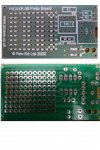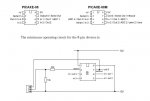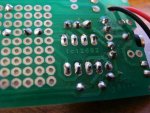120ThingsIn20Years
Senior Member
I thought I'd have a look at the circuit in between soldering attempts, and discovered I understand slightly less than I thought I did.
I didn't that that was possible, but you learn something new every day.
Or not.
I cant figure out what my R1 does.
The right hand side of it just seems to be at a dead end.
I thought I'd try to build it on my little breadboard I bought today to follow the flow and see not just where to put the components, but also see how they interacted with the other components.
So for example the capacitor seems to short circuit straight between the red and black wires.So I did some reading, and from what I can gather I think the capacitor might be used like that to smooth out noise prom the power supply. I cant see why there would be noise, or an uneven voltage, but that doesnt matter right now. It's enough to see that there might be a reason for it
What's got me stumped, is the R1. It seems to just run to a dead end!
That's left me with the feeling that I really should bread board this thing so I understand what it does. It's really dificult for me to see what's going on with the conductive lines being on the other side from the component position markers. But with things like R1 doing it's thing I'm left feeling that I cant trust what I'm doing with the bread board.
I took a photo of the board both sides and flipped the image of the conductive lines so they match up, and I still cant see what that R1 does.

I didn't that that was possible, but you learn something new every day.
Or not.
I cant figure out what my R1 does.
The right hand side of it just seems to be at a dead end.
I thought I'd try to build it on my little breadboard I bought today to follow the flow and see not just where to put the components, but also see how they interacted with the other components.
So for example the capacitor seems to short circuit straight between the red and black wires.So I did some reading, and from what I can gather I think the capacitor might be used like that to smooth out noise prom the power supply. I cant see why there would be noise, or an uneven voltage, but that doesnt matter right now. It's enough to see that there might be a reason for it
What's got me stumped, is the R1. It seems to just run to a dead end!
That's left me with the feeling that I really should bread board this thing so I understand what it does. It's really dificult for me to see what's going on with the conductive lines being on the other side from the component position markers. But with things like R1 doing it's thing I'm left feeling that I cant trust what I'm doing with the bread board.
I took a photo of the board both sides and flipped the image of the conductive lines so they match up, and I still cant see what that R1 does.





